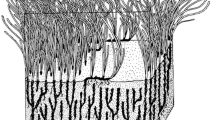Abstract
Seagrass meadows have been shown to be highly productive and of great value to nearshore marine regions. In addition to the utilization of their production by both direct grazing and detrital food chains, considerable amounts of seagrass are transported offshore, often to great distances, where it may serve as food for both surface feeding and benthic feeding organisms.
Seagrass leaves are detached by senescence, storms, and the action of herbivores such as sea urchins and parrotfish. Leaves of turtle grass (Thalassia testudinum) are sometimes seen drifting on the surface, but usually sink rapidly or remain on the bottom, whereas Syringodium filiforme leaves, with larger lacunal spaces, nearly always float to the surface.
In Tague Bay, St. Croix, U.S.V.I., only about 1% of Thalassia production is exported, whereas 60–100% of the Syringodium production is carried out of the system.
Access this chapter
Tax calculation will be finalised at checkout
Purchases are for personal use only
Preview
Unable to display preview. Download preview PDF.
Similar content being viewed by others
References
Greenway, M., 1976. The Grazing of Thalassia testudinum in Kingston Harbour, Jamaica, Aquat. Bot. 2: 117–126.
McRoy, C. P. and C. McMillan, 1973. Production ecology and physiology of seagrasses, Review paper Productivity/ Physiology Working Group, 29 pp., Int. Seagrass Workshop, Leiden, Netherlands.
McRoy, C. P. and C. Helfferich (editors), 1977. Seagrass Ecosystems: A Scientific Perspective, 314 pp., M. Dekker, New York.
Menzies, R. J., J. S. Zaneveld, and R. M. Pratt, 1967. Transported turtle grass as a source of organic enrichment of abyssal sediments off North Carolina, Deep-Sea Res. 14: 111–112.
Menzies, R. J. and G. T. Rowe, 1969. The distribution and significance of detrital turtle grass Thalassia testudinum on the deep sea floor off North Carolina, Int. Rev. Gesamten. Hydrobiol. 54: 217–222.
Moore, D. R., 1963. Distribution of the sea grass Thalassia in the United States, Bull. Mar. Sci. Gulf and Carib. 13: 329–342.
Ogden, J. C. and J. C. Zieman, 1977. Ecological aspects of coral reef - seagrass bed contacts in the Caribbean, Proc., 3rd Int. Coral Reef Symp., 371–382, Rosentiel School Mar. and Atm. Sci., Univ. of Miami.
Roper, C. F. E. and W. L. Brundage, Jr., 1972. Cirrate octopods with associated deep-sea organisms: new biological data based on deep benthic photographs (Cephalopoda), Smithson. Contrib. Zool. No. 121: 1–46.
Ryther, J. H., 1963. Geographic variations in productivity in the sea, In: The Sea; Ideas and Observations on Progress in the Study of the Seas. Vol. 2, edited by M. N. Hill, 347–380, John Wiley & Sons, N. Y.
Thayer, G. W., D. A. Wolfe, and R. B. Williams, 1975. The impact of man on seagrass systems, Amer. Scient. 63: 288–296.
Thayer, G. W., D. W. Engel, and M. W. LaCroix, 1977. Seasonal distribution and changes in the nutritive quality of living, dead and detrital fractions of Zostera marina L., J. Exp. Mar. Biol. Ecol. 30: 109–127.
Thayer, G. W., P. L. Parker, M. W. LaCroix, and B. Fry, in press. The stable carbon isotope ratio of some components of an eelgrass, Zostera marina,bed, Oecologia.
Wolff, T., 1976. Utilization of seagrass in the deep sea, Aquat. Bot. 2: 161–174.
Wood, E. J. F., W. E. Odum, and J. C. Zieman, 1969. Influence of seagrasses on the productivity of coastal lagoons. Laguna Costeras, UN Simposio Mam. Simp. Intern Lagunas Costeras, 495–502, Nov. 28–29, 1967. Mex. DP.
Zieman, J. C., 1974. Methods for the study of the growth and production of turtle grass, Thalassia testudinum Konig, Aquaculture 4: 139–143.
Zieman, J. C., 1975. Quantitative and dynamic aspects of the ecology of turtle grass, Thalassia testudinum, Estuarine Res. 1: 541–562.
Author information
Authors and Affiliations
Editor information
Editors and Affiliations
Rights and permissions
Copyright information
© 1979 Plenum Press, New York
About this chapter
Cite this chapter
Zieman, J.C., Thayer, G.W., Robblee, M.B., Zieman, R.T. (1979). Production and Export of Sea Grasses from a Tropical Bay. In: Livingston, R.J. (eds) Ecological Processes in Coastal and Marine Systems. Marine Science, vol 10. Springer, Boston, MA. https://doi.org/10.1007/978-1-4615-9146-7_2
Download citation
DOI: https://doi.org/10.1007/978-1-4615-9146-7_2
Publisher Name: Springer, Boston, MA
Print ISBN: 978-1-4615-9148-1
Online ISBN: 978-1-4615-9146-7
eBook Packages: Springer Book Archive




